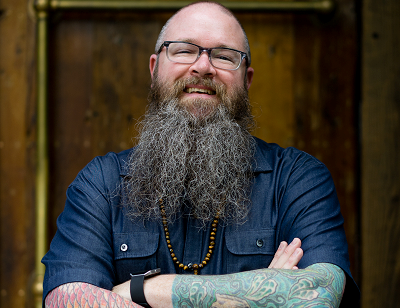
Mark Wyner – “I really love talking about the impact that Artificial Intelligence has on the human experience”.
DevTalks Bucharest is getting closer and we are glad to share with you some thoughts of our awesome speakers of this edition. Mark Wyner who is joining us on the Emerging Tech Stage is looking forward to share his ideas in front of you.
1. You are now developing your personal project MarkWyner.com where you help improve how people interact with digital interfaces. Can you give us more details about it?
My website is really just a simple information hub about me and my work. When I designed it, I wanted to explore some new ways to present information, so I experimented with multiple full-screen layouts. I eventually decided that because my narrative is more or less linear and the content would be very minimal, a magazine-style layout might be a nice approach. I liked the idea of large images that were more symbolic than literal, and wanted to create big blasts of color without using an extensive palette. I’m also a big fan of large typography, and this afforded me an opportunity to play with that.
One interesting challenge was in how I would present my work. UX practitioners often debate about the best way to present our work because it’s not necessarily about showcasing visuals (as with visual design) or functional pieces (as with developers). I settled into the idea of case studies, but wasn’t sure how I wanted to present them. For me, a linear path through the case studies would be best because there would then be no onus on the viewer to choose one case study over another. This also aligned with the magazine-style theme.
2. Along the way, you worked together with partners such as Intel, Nike and Chrysler. What can you tell us about your experience to craft these remarkable products?
Absolutely.
I’ll begin with Intel, who was an amazing partner. They had lots of resources, very interesting projects, and ample timelines for extensive projects. I was able to work with them in the spaces of wearables, automotive IVIs, IoT, and Artificial Intelligence. All of the projects were top-secret, as part of their labs group. This meant we were working with very new technologies to more or less assess their viability by testing how they might be used.
These projects catapulted me deeper into UX work than any of my projects preceding them. I worked with ethnographers, anthropologists, engineers, other UX practitioners, illustrators, developers, animators, and more. Most of the projects ultimately required crafting high-potential use case scenarios, building fully-functional prototypes for testing these scenarios, and then testing them in the field. The idea was to discover the viability of a technology to see if Intel should invest energy into bringing it to market. This was super fun.
The Chrysler project I worked on was perhaps the most interesting of any project I have worked on in my career, and this was a partnership with Intel. It was nearly a two-year timeline, so the work was very comprehensive. We were asked to build a full prototype of an automobile IVI system that employed multiple modalities, multiple screens, and could be demoed in-house for Chrysler executives.
This was super exciting to explore through deep UX work with lots of research and, of course, the building of an emulator that you could sit in and pretend to drive. After months of UX research, storyboarding, and ethnographic work we began design/development of an emulation platform that required four screens that needed to communicate with each other. We used a gaming platform called Unity to craft a scenario that could be driven through and would trigger demonstrations of a broad array of scenarios. The best part is that our work is the scaffolding for Chrysler’s 2018 lines of automobiles, so they’re finally coming to market. And my thumbprint is all over those systems.
My work with Nike was less glamorous, and more about exploring interesting solutions to customize experiences for their global sales team. They had been using a commercial product to send out mission-critical surveys, but weren’t happy with products available on the market. They asked my team to design and build a custom survey system which would save them money, and enable them to fully customize the experience for their global teams. We needed to build a framework that would be extensible, customizable, and even branded uniquely for each group.
3. We share what you’ve learn during your career. Where this passion comes from?
From so many places. When I got into design, about twenty years ago, it was about an interest in aesthetic. Things that were designed well truly captivated me, and I wanted to be able to create visual aesthetic myself.
After a brief period of time someone introduced me to the internet. This was in 1997, so there wasn’t much to it at the time. I didn’t even understand the purpose of it. One of my clients asked me to design a website, and I had no idea what that entailed. I designed some pages and the programmer laughed at me, noting that he couldn’t code my designs because they weren’t possible to reproduce in a browser. He suggested I learned how to code because that would teach me the capabilities/limitations of web design, so I did.
I was immediately enamored with code in the way I had been when I discovered design. I loved being able to see my designs come to life with javascript interactions, and loved the challenge of having to design for infinite canvas sizes. I also just loved writing code.
Eventually I realized that I was just designing and writing code without much purpose. I learned quickly that web technologies were very new, and people were easily frustrated in having to learn how to use them. I thought there must be a way we could make the internet more accessible by making it more pleasant to use. More meaningful. More usable. So that propelled me into the world of UX and IA.
Technology is amazing. I absolutely love the inspiring and magnificent things that human beings are doing with it. But its adoption is often crippled because of shoddy execution. I realized that if we build meaningful experiences for people, they’re more likely to wholly embrace new technologies. For me, I want to contribute to the advancement of amazing technologies, and my work enables me to do just that.
4. Do you have a message for the DevTalks’ audience?
I am not an engineer, and I can’t write a line of code in the spaces of computer science or machine learning. My perspectives on Artificial Intelligence are through a lens of the impact that AI has on the human experience, and that is what I want to share with everyone. I really love talking about this stuff, and very much look forward to sharing my ideas.














